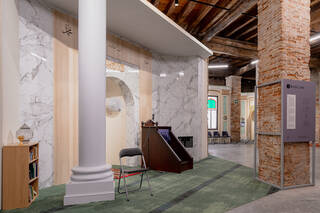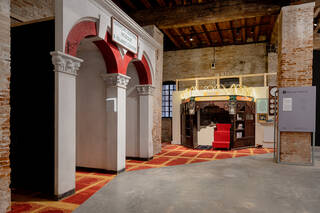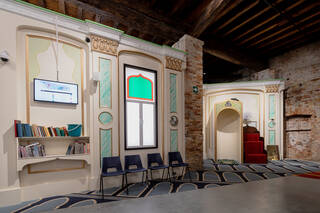In our fifth year of collaboration, La Biennale di Venezia and the V&A presented 'Three British Mosques'.
Responding to the theme 'How will we live together?' set by Lebanese architect Hashim Sarkis, the 2021 display explored contemporary multiculturalism through three adapted mosque spaces in London, whose stories are told within the setting of a pavilion installation.
In collaboration with author and architect Shahed Saleem, the pavilion looked at the self-built and often undocumented world of adapted mosques. Through 3D architectural reconstructions, photographs, and filmed interviews from artist Julie Marsh, the installation explored the case studies of Old Kent Road mosque, housed in a former pub; the Brick Lane mosque, a former Protestant chapel then Synagogue; and Harrow Central mosque, a purpose-built space that sits next door to the converted semi-detached houses it used to occupy.

In Britain any group can start a mosque, without appeal or approval from a higher religious authority. Most mosques have been created by adapting existing buildings – from houses, shops, cinemas, pubs as well as other former places of worship. Often communities actively fundraise to build new mosques on these sites to better meet their community's needs.

The first mosque in Britain was created in 1889 by adapting a terraced house in Liverpool, and there are now 1,800 mosques across the country. The history of the mosque in Britain is one of cultural dialogue, with different histories merging and presenting new opportunities for our urban fabric to evolve. Designed – and in many cases – built by its users, the mosque has given Britain an entirely new form of architecture.

"Shahed Saleem has carried out a comprehensive study of the history of the British mosque and has also designed several. The V&A has worked with him to explore three different case studies that illuminate stories of immigration, identity, and community aspiration. Most mosques in Britain are grass-roots, crowdsourced, community projects that exemplify creative reuse. As new-build mosques replace these ad-hoc structures, this form of community-led design is being lost. The V&A's pavilion is an attempt to record and celebrate this stage of mosque-making in Britain."

Three British Mosques was on display at the Venice Biennale from 22 May – 21 November 2021.
The Applied Arts Pavilion Special Project has been made possible thanks to lead support from Volkswagen Group and donors to the Venice Architecture Biennale Fund in memory of Dr Martin Roth.



